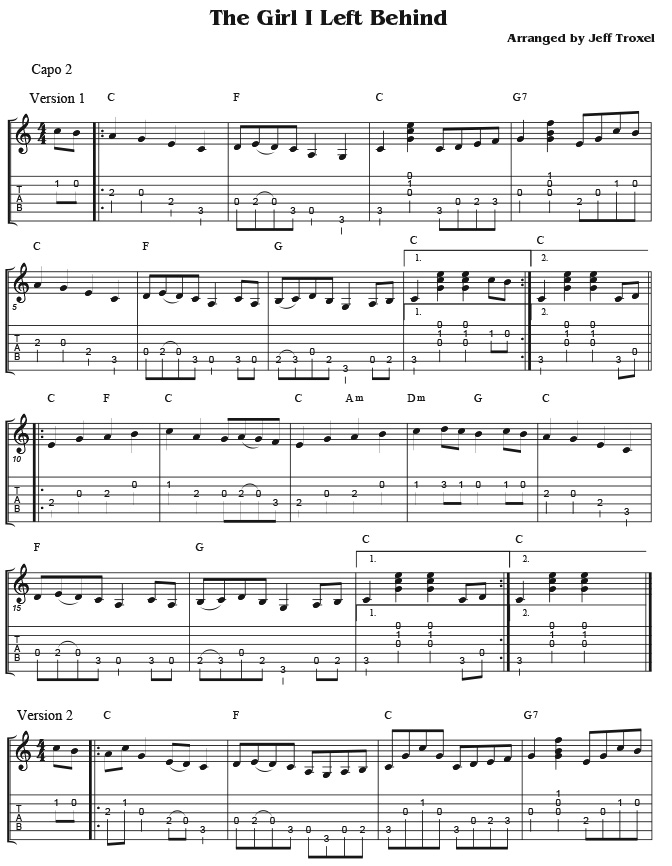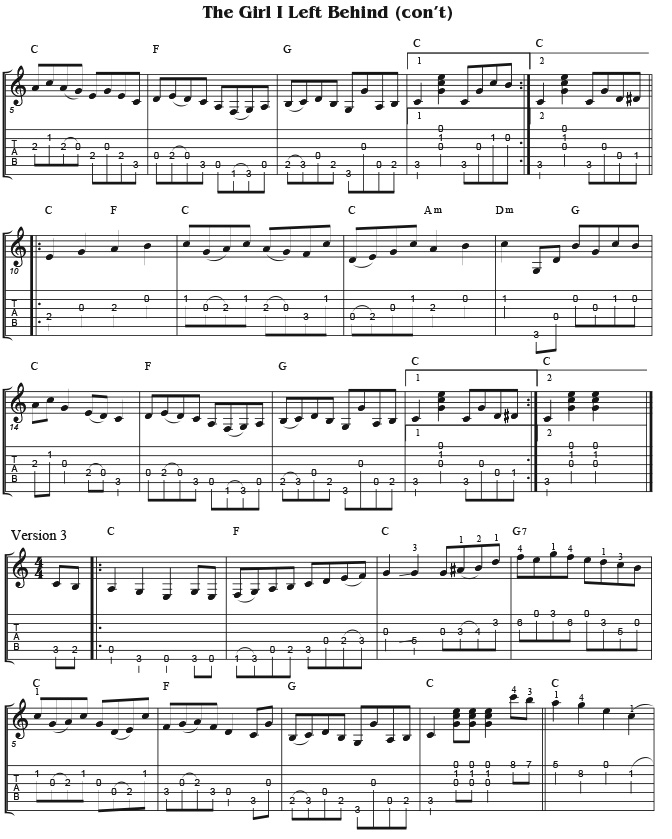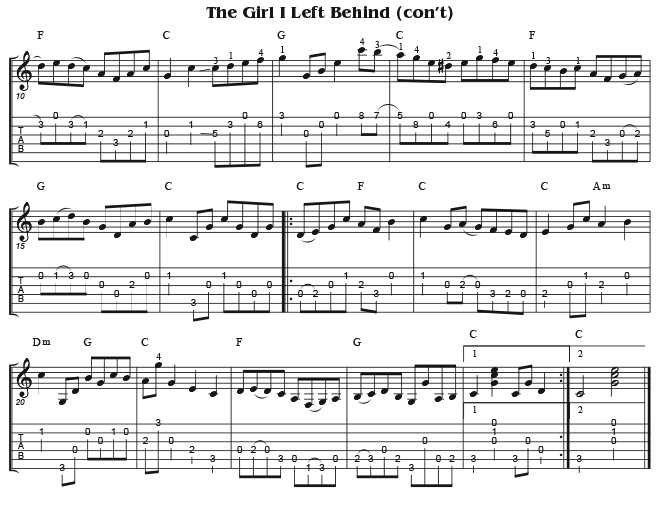|
Flatpicking Guitar Magazine Free Monthly Lesson “The Girl I Left Behind Me” Arranged by Jeff Troxel
Download PDF | Download fast mp3 | Download slow mp3 This month we are diving into the Flatpicking Guitar Magazine archives to provide you with the free lesson. We’ve selected the great old tune “The Girl I Left Behind Me” as arranged by Jeff Troxel for the January/February 2009 issue (Volume 13, Number 2). Jeff provides several different arrangements of the tune, using them as examples to demonstrate how to create a variety of arrangements for fiddle tunes.
Here is Jeff's text for this article:
Arranging a Fiddle Tune Hello everybody, and welcome back. In this issue I’m going to demonstrate some ways to vary a simple fiddle tune. “The Girl I Left Behind” is a very old song dating back to the Napoleonic wars and its catchy little melody will work great for our purposes. But before we dive in, let’s take a moment to discuss the importance of learning variations and how they can influence musicianship. Here are a few reasons for incorporating them into your practice routine and repertoire: 1) Variations offer the chance to employ different melodic techniques, thus improving your overall playing. 2) Learning variations allows you to play a tune several times through without repeating yourself, giving the audience and you a more rewarding musical experience. 3) Variations form the basis for improvisation. By randomly mixing and matching parts of different versions you are, in a sense, improvising. As you learn more tunes and variations you’ll have a larger pool of ideas from which you can draw. 4) Learning someone else’s arrangement with the idea of borrowing ideas gets you thinking like a composer. It puts the ears and intellect out ahead of the fingers and helps lay the foundation for intuition to take root. It also teaches you a lot about tone, phrasing and execution. With all this in mind, let’s take a look at “The Girl I Left Behind.” Version 1 is a straight-forward, but still respectable presentation of the tune. There’s nothing fancy going on, but neither does it sacrifice anything musically for the sake of simplicity. It features a mix of eighth-notes and quarter-notes, with some slurs and self accompaniment (chord strumming) thrown in. Version 2 fills in some of the quarter-note measures with more melodic complexity. Notice how cross-picking takes the place of a strum in measures 3, 8, and 17. Also notice how the lick in measure 11 of Version 2 still follows the melody but offsets the “A” note by one beat. Measure 13 of Version 2 anticipates the G chord with a wide crosspicking lick. None of these techniques change the tune very much. Important melodic notes are still present; they’re just dressed a little differently. Version 3 is the most “adventurous” of the three. It also shows a great way to vary a melody by placing it in different octaves. The first “A” section takes the melody down an octave. In the first measure, the melody would go too low to play it exactly in this octave, so we opt for a lick that takes us back up. Then the melody disappears for a bit in measures 2, 3 and 4, but comes back at measure 5. This is an important point to understand. Measure 5 is the beginning of the next phrase and, by having the melody return at this strong point in the song, we can get away with our small melodic transgression. In other words, having the melody present at key places leaves openings for improvisation to occur in between. The second “A” section takes the song up an octave. Measures13 and 14 use the same technique of breaking from and returning to the melody found in the first “A” section. The slurs and slides employed throughout this version are yet another way you can spice up and personalize an arrangement. There are many ways you can approach a learning tune like this, but allow me to make some recommendations for those who desire a little guidance: 1) Learn the simplest version first. If necessary, change a few things around to make it feel natural to you and start to “make it your own.” This isn’t classical music and the written notes shouldn’t be given too much authority. Use the recordings to help get the song into your ears. 2) Memorize your first version so you can play the melody and the chord progression without looking at the music. 3) You can either learn the other versions in their entirety or you can mine them for ideas. If you hear something that catches your attention on the recording, go to the music and learn that one element. Try extracting it and placing it into the same spot in your first version. This may require some smoothing around the edges to make it fit properly, but you won’t get arrested for changing a few notes around to make it fit. And again, this puts us into the realm of composer/arranger. 4) Repeat this same process with every new tune you learn so you keep planting new ideas in your brain. Listening to recordings of the tunes you’re learning is not only a good way to get new ideas for your variations, it’s also one of the most important things you can do for your overall musical growth. It’s impossible to be a good musician without a commitment to listening on a regular basis. 5) Devote enough time to practicing to accomplish your goals. I’ve encountered a number of students over the years who confused their lack of commitment with a lack of talent. Don’t underestimate how much time great players spend with the instrument in their hands. And let me state once more the importance of memorization in this process (number 2 above). Getting a tune off the page and into your head places it in your long-term memory where it’s free to hang around and blend with other musical ideas residing there. After you’ve put enough music in there it’s only a matter of time before new and surprising things start to pop out during your performances. Reading a tune from the page keeps it on the surface where it can’t create that synergy. By freeing the eyes, memorization opens the ears. Try it and you’ll see what I mean. As you continue adding songs and variations to your repertoire you might start to feel like you’re doing more memorization than improvisation. But with enough time, practice and listening, things will start to happen. The tunes you used to play the same every time will start to show up with some new twists. You’ll have to trust me on this one.



|